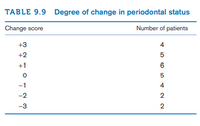
In a study, 28 adults with mild periodontal disease are assessed before and 6 months after implementation of a dental-education program intended to promote better oral hygiene. After 6 months, periodontal status improved in 15 patients, declined in 8, and remained the same in 5.
9.1 Assess the impact of the program statistically (use a two-sided test).
Suppose patients are graded on the degree of change in periodontal status on a 7-point scale, with +3 indicating the greatest improvement, 0 indicating no change, and −3 indicating the greatest decline. The data are given in Table 9.9.
9.2 What nonparametric test can be used to determine whether a significant change in periodontal status has occurred over time?
9.3 Implement the procedure in Problem 9.2 and report a p-value.

Trending nowThis is a popular solution!
Step by stepSolved in 2 steps

- Reports show that 92% of online searches in March 2021 use Google as the search engine. A network administrator wants to determine whether the percentage of searches that use Google is different in their company. They sample 800 searches and find that 758 of them use Google. Can they conclude that the percentage of searches that use Google in this company differs from 92%? Use the a = 0.05 level of significance.arrow_forwardWhat is the difference between treatment variability and error variability in factorial Designs?arrow_forwardA researcher compares differences in positivity between participants in a low-, middle-, or upper-middle-class family. If she observes 15 participants in each group, then what are the degrees of freedom for the one-way between-subjects ANOVA?arrow_forward
- Results from the National Health and Nutrition Examination Survey (NHANES) conducted thirty years ago revealed that out of 378 randomly selected adults in the United States 57 were considered to be obese. In this year’s National Health and Nutrition Examination Survey, out of 426randomly selected adults in the United States 135 were considered to be obese. Based on these results, can one conclude, at the 0.01 level of significance, that the percentage of adults in the United States that are obese is considerably higher now than it was thirty years ago?arrow_forwardIndividual actions can play a large role in the overall health of our planet. A researcher interested in evaluating environment friendly behaviors evaluated how often people recycle (per month) based on whether they have an overall optimistic or an overall pessimistic attitude toward eco-friendly behaviors. The results from this hypothetical study are given in the table. Test whether or not recycling behaviors differed between groups using a .05 level of significance. State the value of the test statistics and the decision to retain or reject the null hypothesis. Compute effect size using eta- squared (n^2). Pessimistic Optimistic 3 4 0 9 4 6 2 8 1 9 6 5 3 6 5 8 0 6 5 7arrow_forwardWould a descriptive, correlational, independet and dependent variable, quasi-experimental or experiemental, quantitative research design be best for a research question regarding social skills training versus pharmacological treatment?arrow_forward
- Acne is a common skin disease that affects most adolescents and can continue into adulthood. A study compared the effectiveness of three acne treatments and a placebo, all in gel form, applied twice daily for 12 weeks. The study's 517 teenage volunteers were randomly assigned to one of the four treatments. Success was assessed as clear or almost clear skin at the end of the 12 week period. The results of the study can be seen in the table below. Using the appropriate statistical test, determine if there is significant evidence that the four treatments perform differently. If so, how do they compare.arrow_forwardWhat is the turkey HSD for week 0 and week 4 comparison?arrow_forwardUse an ANOVA with ? = 0.05 to determine whether there are any significant differences among the three treatment means. If results are significant what is the effect size? Report results in APA format A developmental psychologist is examining the development of language skills from age 2 to 4. Three different groups are obtained, one for each age, with n = 16 children in each group. Each child is given a language-skills assessment test. The resulting data were analyzed with an ANOVA to test for mean differences between age groups. The results of the ANOVA are presented in the following table. Fill in all missing values. N = , n = , K = Source SS df MS F Between Txt 20 Within Txt Total 200arrow_forward
 MATLAB: An Introduction with ApplicationsStatisticsISBN:9781119256830Author:Amos GilatPublisher:John Wiley & Sons Inc
MATLAB: An Introduction with ApplicationsStatisticsISBN:9781119256830Author:Amos GilatPublisher:John Wiley & Sons Inc Probability and Statistics for Engineering and th...StatisticsISBN:9781305251809Author:Jay L. DevorePublisher:Cengage Learning
Probability and Statistics for Engineering and th...StatisticsISBN:9781305251809Author:Jay L. DevorePublisher:Cengage Learning Statistics for The Behavioral Sciences (MindTap C...StatisticsISBN:9781305504912Author:Frederick J Gravetter, Larry B. WallnauPublisher:Cengage Learning
Statistics for The Behavioral Sciences (MindTap C...StatisticsISBN:9781305504912Author:Frederick J Gravetter, Larry B. WallnauPublisher:Cengage Learning Elementary Statistics: Picturing the World (7th E...StatisticsISBN:9780134683416Author:Ron Larson, Betsy FarberPublisher:PEARSON
Elementary Statistics: Picturing the World (7th E...StatisticsISBN:9780134683416Author:Ron Larson, Betsy FarberPublisher:PEARSON The Basic Practice of StatisticsStatisticsISBN:9781319042578Author:David S. Moore, William I. Notz, Michael A. FlignerPublisher:W. H. Freeman
The Basic Practice of StatisticsStatisticsISBN:9781319042578Author:David S. Moore, William I. Notz, Michael A. FlignerPublisher:W. H. Freeman Introduction to the Practice of StatisticsStatisticsISBN:9781319013387Author:David S. Moore, George P. McCabe, Bruce A. CraigPublisher:W. H. Freeman
Introduction to the Practice of StatisticsStatisticsISBN:9781319013387Author:David S. Moore, George P. McCabe, Bruce A. CraigPublisher:W. H. Freeman





